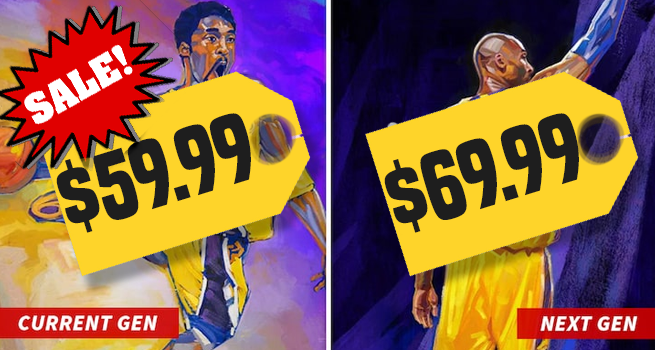Update: This article previously mixed up 2K and EA because I don’t play sports games at all and got the yearly basketball games mixed up, apparently. My apologies. All the rest of my points still stand, and I’ve corrected the couple of erroneous instances where I said EA instead of 2K.
Today we received the first whiff of a major new change coming to the video game industry with next-gen: a price jump to $70—or rather, $69.99—for new games. While it’s yet to be confirmed as a broad change, limited at this time to the next-gen version of NBA 2K21, the writing is basically on the wall at this point. Prices for video games are going up. $59.99 is about to be a “discount” price for a game.
And yet, while it’s a jarring change to the norms we’re used to, it’s not entirely unexpected. In fact, many expected prices to jump $10 back at the start of this generation in 2013, but that didn’t happen. Publishers and developers instead offset that cost in other ways. By the rate of inflation, we should technically be seeing a jump to $79.99 for new full-size games this year, but of course that comes with mountains of caveats.
See, the biggest reason we haven’t seen a price increase is that a lump sum is hard to swallow. Telling people to fork over even $60 for a brand new game is a difficult ask, let alone $10 or $20 more than that. So instead publishers and developers have been focusing on ways to break that price up into more manageable and easier to digest costs, some to better reception that others. The last decade has been a period of experimentation on what’s acceptable within the games industry. Microtransactions, subscription costs, add-ons, deluxe editions with bonuses—it’s all done in an effort to balance the books while providing the most reasonable value proposition for the consumer.
What’s the ‘Value’ of a Game?
Of course, the idea that a video game’s inherent value is $60 (or $70 or $80) is a fallacy. Is it based on play time? “Content” (whatever that means)? File size? Is it the size of the studio and the amount of people making the game? Is it the publisher at it’s back? Is it how long it’s been in development? It’s an impossible question to answer, and even if it weren’t, there’s no singular consensus point that arrives back to the conclusion that every game’s inherent new market value is $60.
After all, every studio is different. Budgets for every game are different. Sales projections are all different. Take, for example, this thought experiment. If you could sell a game to one person for $70, or two people for $50 each, you could feasibly make more money at the lower price point. But if both people were willing to buy the game at $70, then by lowering the price, you are losing money. That’s the most very basic thoughts that are going on in publishing departments. Now you have to add piles of other considerations, including attach rates of DLC and add-ons, microtransactions, etc. as well as the inherent cost to develop those additional features. It’s an analyst’s nightmare (or dream, if they’re a bit sadistic).
While I do believe that 2K is setting the bar at $70 PS5 game prices, I also think we’re likely to see a lot more variable pricing, discounts, pushes for subscription services, and other strategies to offset that increase in price. Think about it this way. A discount to $50 of a $60 game doesn’t seem like that much, but on a $70 game? Suddenly that $50 price point seems like a huge decrease in the new release retail. The “I’ll wait for a discount crowd” will potentially be willing to spend more based on the psychology of where the base price lies. It’s a similar reason why things are priced at $59.99 instead of $60.00. The psychology of seeing a 5 versus a 6 is enormous, despite the difference only being a single cent.
Variable pricing used to be most prevalent within indie games, which all hovered anywhere from $10 to $30. But lately we’ve seen more big franchises approaching the model, most notably with remakes and “smaller” games like Uncharted: The Lost Legacy frequently releasing at $40. AA titles usually hover around this lower price point too, to be seen as an attractive and cheaper alternative to the big budget high-priced new releases. It’s all a game of financial strategy and attracting consumers’ limited dollars.
The World’s Changing, Guardian. We Must Prepare and Adapt
See, studios have to account for the people who just buy a few games every year. They have to account for the super fans. They have to account for the skeptics. They have to account for the hardcore gamers. They have to account for the weekend warriors. A game like NBA 2K21 is going to have a much easier time simply saying “the price of this game on PS5 is $70” and barely having anyone bat an eye. Sports franchises are enormous, and live well beyond the realm of the relatively small “video games community” that keeps up with things via Twitter and reads gaming news sites every day. For them, it’s just the march of progress. They might glance at the price, notice the increase, but ultimately it won’t affect their purchasing decisions.
What this increase does do, however, is open up a world of additional possibilities on allowing publishers and developers to have flexible models and pricing with their games. Somebody who is skeptical of the $70 PS5 game price for a brand new EA game might be a little more convinced to look into that EA Access subscription service, a cost that’s far easier to digest in bite-size portions. Plus it’s an increased value proposition, as players now have access to an even wider EA games catalog.
And then you have to consider free-to-play games. Even massive titles like Call of Duty and Destiny have moved to assorted strategies that adapt this model. Again, it’s designed as a gateway to an ecosystem. Your ticket for entry is free, and buying things once inside is cheaper and easier to justify than a brand new $60—or $70—release.
It’s something I talked about last year. The games as a service model was always preparing to evolve into the “consoles as a service” model. Services like Xbox GamePass, Google Stadia, EA Access, and PlayStation Now and Plus are leading the way, with varying strategies and degrees of success. Developers and publishers would rather have you as part of their ecosystem, guaranteeing future income, rather than have to gamble with every new release. It just balances out better that way. And the cost of that balance is an increase in the base price of video games. The price of the entree is just going to be less valuable than the combo meal or buffet options. It’s why Comcast’s internet package is so expensive, while the internet + TV bundle is cheaper, to lock you into the ecosystem.
In fact, it’s surprising that it’s taken games this long to adapt. Film, music, and even books have embraced subscription and variable pricing for years. And as you see costs for a movie tickets in theaters rise (remember those, from before the pandemic?), we saw subscription streaming services like Netflix, Amazon, Hulu, and HBO securing exclusive movies and series to convince people that their platform was the necessary one. After all, you aren’t seeing The Witcher in theaters. People who wouldn’t have even bought two new music albums in a year now pay $10 a month to stream Spotify. People who wouldn’t ever consider buying movies or TV shows on disc (or even to own digitally) will have four different streaming services to watch everything they want to.
We’ve seen it slowly start to pervade the games industry, but this PS5 video game price increase to $70 next-gen proves it’s finally here. Just like with movies, music, and books, it’s not going to prevent the sale of individual games. It’s not a strategy that’s meant to. But it will give consumers a lot more options and value in the long run as we move ever closer towards ecosystems being the driving force behind the industry.
I wouldn’t even be surprised if we one day see “service exclusive” games to continue to wrangle players into specific ecosystems. It’s just one of a few different models and pricing strategies I think we’ll see played around with. It’s a topic for another conversation, but 2K is also doing it’s own thing with next-gen upgrades for NBA 2K21, similar to the various bizarre experiments we saw moving from PS3 to PS4. As always, the industry will weed out what doesn’t work and the course of the river will begin to flow to what is most acceptable for all parties as developers and publishers seek to make money and players seek to find value in an increasingly expensive hobby.
Daily Reaction reacts to the video game industry. Have suggestions for the column or subjects you’d like us to react to? Let me know in the comments below and be sure to check out previous Daily Reactions for more dives beyond the headlines.










